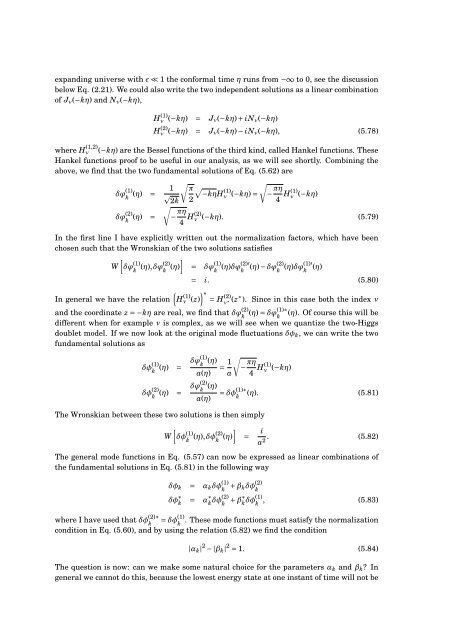Master's Thesis in Theoretical Physics - Universiteit Utrecht
Master's Thesis in Theoretical Physics - Universiteit Utrecht
Master's Thesis in Theoretical Physics - Universiteit Utrecht
You also want an ePaper? Increase the reach of your titles
YUMPU automatically turns print PDFs into web optimized ePapers that Google loves.
expand<strong>in</strong>g universe with ɛ ≪ 1 the conformal time η runs from −∞ to 0, see the discussionbelow Eq. (2.21). We could also write the two <strong>in</strong>dependent solutions as a l<strong>in</strong>ear comb<strong>in</strong>ationof J ν (−kη) and N ν (−kη),H (1)ν (−kη) = J ν(−kη) + iN ν (−kη)H (2)ν (−kη) = J ν(−kη) − iN ν (−kη), (5.78)where H (1,2)ν (−kη) are the Bessel functions of the third k<strong>in</strong>d, called Hankel functions. TheseHankel functions proof to be useful <strong>in</strong> our analysis, as we will see shortly. Comb<strong>in</strong><strong>in</strong>g theabove, we f<strong>in</strong>d that the two fundamental solutions of Eq. (5.62) areδϕ (1)k (η) = 12k√ π2δϕ (2)k (η) = √− πη4 H(2) ν√√−kηH(1)ν (−kη) = − πη4 H(1) ν(−kη)(−kη). (5.79)In the first l<strong>in</strong>e I have explicitly written out the normalization factors, which have beenchosen such that the Wronskian of the two solutions satisfies[]W δϕ (1)k (η),δϕ(2) k (η) = δϕ (1)k (η)δϕ(2)′ (η) − δϕ(2)kk (η)δϕ(1)′ k(η)= i. (5.80)( )In general we have the relation H ν(1) ∗(z) = H(2)ν(z ∗ ). S<strong>in</strong>ce <strong>in</strong> this case both the <strong>in</strong>dex ν∗and the coord<strong>in</strong>ate z = −kη are real, we f<strong>in</strong>d that δϕ (2) (η) = δϕ(1)∗(η). Of course this will bek kdifferent when for example ν is complex, as we will see when we quantize the two-Higgsdoublet model. If we now look at the orig<strong>in</strong>al mode fluctuations δφ k , we can write the twofundamental solutions asδφ (1)kδφ (2)kδϕ(1)k(η) = (η)= 1 a(η) aδϕ(2)k(η) = (η)a(η)√− πη4 H(1) νThe Wronskian between these two solutions is then simply[]W δφ (1)k (η),δφ(2) k (η)(−kη)= δφ (1)∗ (η). (5.81)k=ia 2 . (5.82)The general mode functions <strong>in</strong> Eq. (5.57) can now be expressed as l<strong>in</strong>ear comb<strong>in</strong>ations ofthe fundamental solutions <strong>in</strong> Eq. (5.81) <strong>in</strong> the follow<strong>in</strong>g wayδφ k = α k δφ (1)k + β kδφ (2)kδφ ∗ k= α ∗ k δφ(2) k+ β∗ k δφ(1) k , (5.83)where I have used that δφ (2)∗ = δφ (1) . These mode functions must satisfy the normalizationk kcondition <strong>in</strong> Eq. (5.60), and by us<strong>in</strong>g the relation (5.82) we f<strong>in</strong>d the condition|α k | 2 − |β k | 2 = 1. (5.84)The question is now: can we make some natural choice for the parameters α k and β k ? Ingeneral we cannot do this, because the lowest energy state at one <strong>in</strong>stant of time will not be
















